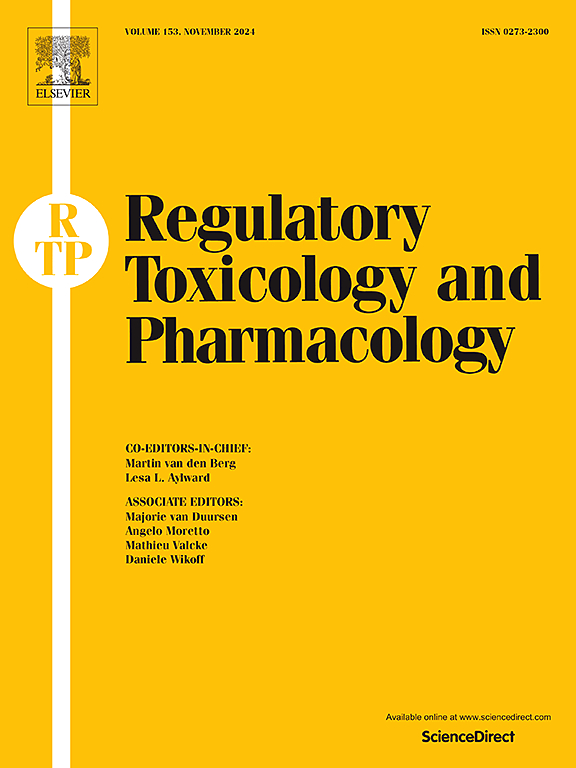Mechanism and marker of voriconazole–induced liver injury: insights from a quantitative systems toxicology approach
IF 3
4区 医学
Q1 MEDICINE, LEGAL
引用次数: 0
Abstract
Liver injury severely limits the clinical use of voriconazole. Clarifying the mechanism and markers of voriconazole–induced liver injury is of great significance. In this study, a quantitative systems toxicology model of voriconazole–induced liver injury was constructed through integrating the mechanism–based hepatoxic parameters generated from in vitro assays into a self–built physiologically based pharmacokinetic model. The hepatotoxic substances, main mechanism, dose correlation and markers of voriconazole–induced liver injury were determined according to liver injury incidence of simulated populations. The voriconazole–treated mice, voriconazole or voriconazole N–oxide (VNO)–treated HepG2 were used to validate the relationship of liver injury with oxidative stress and VNO. The results demonstrated that the incidence of voriconazole–induced liver injury was 17.9 %, which was dose–dependent. VNO–induced oxidative stress contributed most to liver injury, which was manifested by reactive oxygen species (ROS) accumulation and antioxidant enzymes inhibition. Liver ROS/reactive nitrogen species baseline clearance Vmax and antioxidant enzymes activities were negatively correlated to plasma liver function indicators elevation and liver adenosine triphosphate loss. We concluded that VNO–induced oxidative stress was the main cause of voriconazole–induced liver injury, and basic antioxidant capability indicators might be potential markers. This study may provide new insights for mechanism understanding and early warning of voriconazole–induced liver injury.
伏立康唑诱导肝损伤的机制和标志物:从定量系统毒理学方法的见解。
肝损伤严重限制了伏立康唑的临床应用。阐明伏立康唑致肝损伤的机制和标志物具有重要意义。本研究通过将体外实验产生的基于机制的肝氧化参数整合到自建的基于生理的药代动力学模型中,构建伏立康唑致肝损伤定量系统毒理学模型。根据模拟人群肝损伤发生率,测定伏立康唑致肝损伤的肝毒性物质、主要机制、剂量相关性及标志物。采用伏立康唑处理小鼠、伏立康唑或伏立康唑n -氧化物(VNO)处理HepG2,验证氧化应激和VNO对肝损伤的影响。结果表明,伏立康唑致大鼠肝损伤发生率为17.9%,且呈剂量依赖性。vno诱导的氧化应激是导致肝损伤的主要原因,表现为活性氧(ROS)积累和抗氧化酶抑制。肝脏ROS/活性氮种基线清除率Vmax和抗氧化酶活性与血浆肝功能指标升高和肝脏三磷酸腺苷损失呈负相关。我们认为vno诱导的氧化应激是伏立康唑致肝损伤的主要原因,基础抗氧化能力指标可能是潜在的标志物。本研究为伏立康唑致肝损伤的机制认识和早期预警提供了新的思路。
本文章由计算机程序翻译,如有差异,请以英文原文为准。
求助全文
约1分钟内获得全文
求助全文
来源期刊
CiteScore
6.70
自引率
8.80%
发文量
147
审稿时长
58 days
期刊介绍:
Regulatory Toxicology and Pharmacology publishes peer reviewed articles that involve the generation, evaluation, and interpretation of experimental animal and human data that are of direct importance and relevance for regulatory authorities with respect to toxicological and pharmacological regulations in society. All peer-reviewed articles that are published should be devoted to improve the protection of human health and environment. Reviews and discussions are welcomed that address legal and/or regulatory decisions with respect to risk assessment and management of toxicological and pharmacological compounds on a scientific basis. It addresses an international readership of scientists, risk assessors and managers, and other professionals active in the field of human and environmental health.
Types of peer-reviewed articles published:
-Original research articles of relevance for regulatory aspects covering aspects including, but not limited to:
1.Factors influencing human sensitivity
2.Exposure science related to risk assessment
3.Alternative toxicological test methods
4.Frameworks for evaluation and integration of data in regulatory evaluations
5.Harmonization across regulatory agencies
6.Read-across methods and evaluations
-Contemporary Reviews on policy related Research issues
-Letters to the Editor
-Guest Editorials (by Invitation)

 求助内容:
求助内容: 应助结果提醒方式:
应助结果提醒方式:


